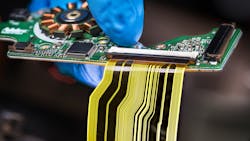Making the Switch to Ultra-Thin Flex PCBs—Advantages and Apps
This article is part of TechXchange: PCB Tools and Technology.
What you’ll learn about:
- Advantages and applications of ultra-thin flexible PCBs.
- Materials used in ultra-thin flexible PCBs.
As the name suggests, ultra-thin flexible PCBs are much thinner than standard PCBs, as well as lighter and more compact. They’ve also been gaining in popularity, and not without reason. With the increasing demand for miniaturization, their use has become ubiquitous. Extremely lightweight and highly flexible, they offer a variety of advantages.
Advantages of Ultra-Thin Flexible PCBs
Some benefits of ultra-thin flex PCBs include:
- Because they’re so thin, they tend to use less materials, thus lowering costs.
- They work well with advanced techniques such as laser direct imaging.
- They’re known for reliability, which means products that use them stand the test of time.
- They have conductors with polyimide coatings, which will protect them in extremely harsh conditions.
- They work well in environments despite high levels of vibration, thanks to their high ductility and low mass. They also withstand repeated flexing cycles.
Materials
Some of the materials that make such ultra-thin PCBs possible include:
- A thin base material that helps miniaturize the boards.
- Copper layers to fill connections.
- Polyimide coatings that offer protection without adding mass.
- Layers of adhesive that let the circuit board withstand flexing.
- Thin flexible substrates.
Applications
Ultra-thin flex PCBs have the density and precision of a rigid circuit board and can fit most any space, making them suitable for a host of applications. Areas where they find widespread use include:
- Medical devices such as implants and hearing aids
- SIM cards
- Wiring harnesses. In fact, using these boards means that you don’t need to color-code wires. This results in lower installation costs as well as fewer failures. They also offer better connections.
- Metro coins
- GPS devices
- Printers
- Automotive engine controls
Quality Standards
These PCBs must be manufactured to the highest quality standards. These include:
- REACH
- IPC
- RoHS
- UL
- ISO
- CE
- ITAR
In addition, before manufacturing such PCBs, keep in mind these considerations:
- Ensure you go with a manufacturer with experience in their production. It requires competence in design and fabrication technology. In fact, only experienced manufacturers can handle certain aspects of making these PCBs. For example, some of these PCBs are fabricated using a batch process. In addition, the fabrication process should be managed by highly trained personnel—any changes or repairs need to be done carefully.
- Advanced methods such as laser direct imaging can be used, but the registration processes must be precise and accurate.
- It requires extremely efficient handling because thin substrates can warp. Also, smaller dimensions mean far higher fabrication precision.
- While these boards have lower material costs, the expense of extra fixtures and handling must be carefully balanced.
Using the right contract manufacturer for ultra-thin flex PCBs can make the difference between the success or failure of a product. The right manufacturer also can custom create PCBs that offer high performance and are available at competitive prices.
Read more articles in TechXchange: PCB Tools and Technology.
About the Author
Suresh Patel
Sales Engineer, Mer-Mar Electronics
Suresh Patel has worked as a Sales Engineer and held other management roles at Mer-Mar. He brings 25 years of experience in printed-circuit-board sales and technical client service and managing business.

